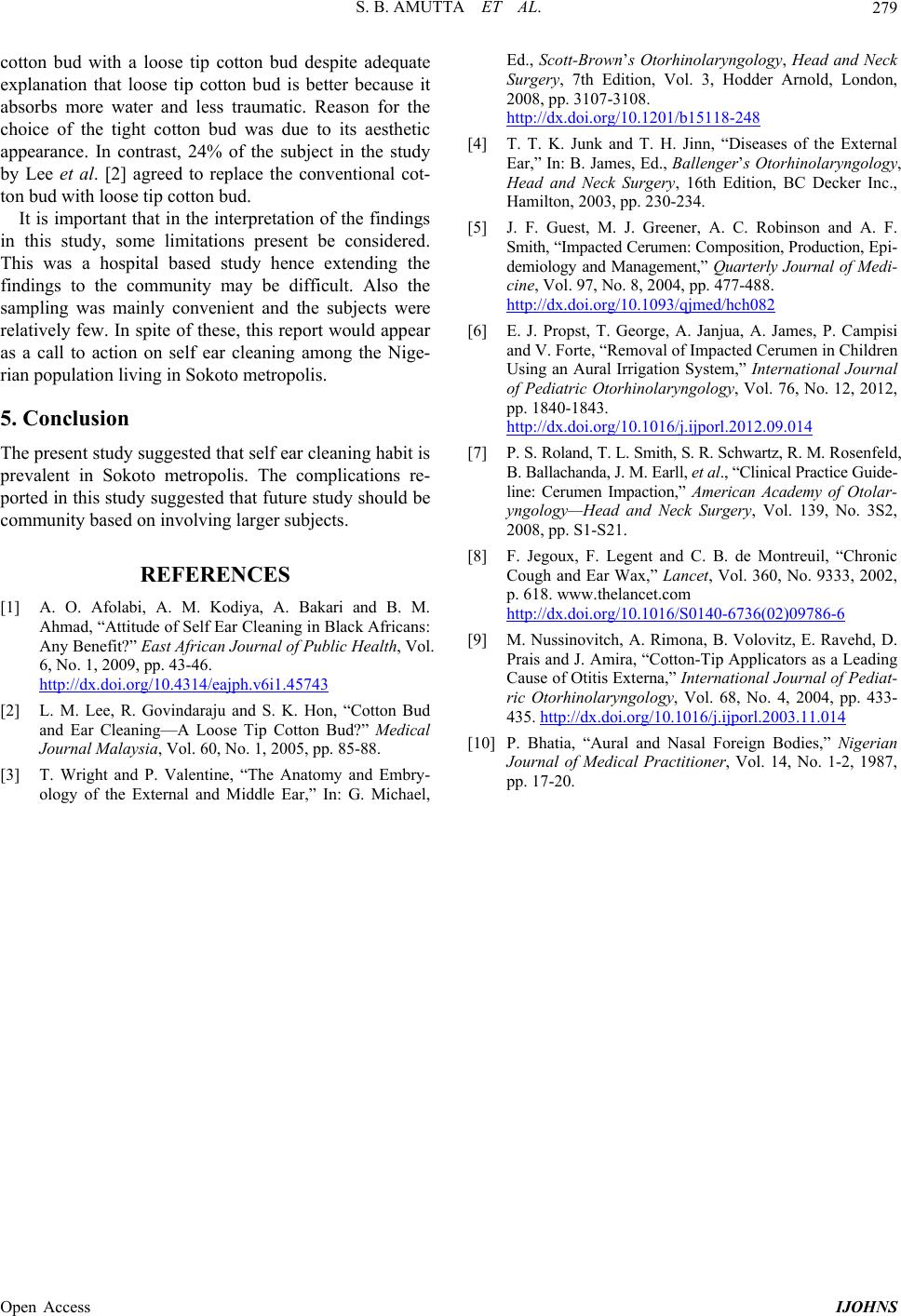
S. B. AMUTTA ET AL.
Open Access IJOHNS
279
cotton bud with a loose tip cotton bud despite adequate
explanation that loose tip cotton bud is better because it
absorbs more water and less traumatic. Reason for the
choice of the tight cotton bud was due to its aesthetic
appearance. In contrast, 24% of the subject in the study
by Lee et al. [2] agreed to replace the conventional cot-
ton bud with loose tip cotton bud.
It is important that in the interpretation of the findings
in this study, some limitations present be considered.
This was a hospital based study hence extending the
findings to the community may be difficult. Also the
sampling was mainly convenient and the subjects were
relatively few. In spite of these, this report would appear
as a call to action on self ear cleaning among the Nige-
rian population living in Sokoto metropolis.
5. Conclusion
The present study suggested that self ear cleaning habit is
prevalent in Sokoto metropolis. The complications re-
ported in this study suggested that future study should be
community based on involving larger subjects.
REFERENCES
[1] A. O. Afolabi, A. M. Kodiya, A. Bakari and B. M.
Ahmad, “Attitude of Self Ear Cleaning in Black Africans:
Any Benefit?” East African Journal of Public Health, Vol.
6, No. 1, 2009, pp. 43-46.
http://dx.doi.org/10.4314/eajph.v6i1.45743
[2] L. M. Lee, R. Govindaraju and S. K. Hon, “Cotton Bud
and Ear Cleaning—A Loose Tip Cotton Bud?” Medical
Journal Malaysia, Vol. 60, No. 1, 2005, pp. 85-88.
[3] T. Wright and P. Valentine, “The Anatomy and Embry-
ology of the External and Middle Ear,” In: G. Michael,
Ed., Scott-Brown’s Otorhinolaryngology, Head and Neck
Surgery, 7th Edition, Vol. 3, Hodder Arnold, London,
2008, pp. 3107-3108.
http://dx.doi.org/10.1201/b15118-248
[4] T. T. K. Junk and T. H. Jinn, “Diseases of the External
Ear,” In: B. James, Ed., Ballenger’s Otorhinolaryngology,
Head and Neck Surgery, 16th Edition, BC Decker Inc.,
Hamilton, 2003, pp. 230-234.
[5] J. F. Guest, M. J. Greener, A. C. Robinson and A. F.
Smith, “Impacted Cerumen: Compositi on, Product ion, E pi -
demiology and Management,” Quarterly Journal of Medi-
cine, Vol. 97, No. 8, 2004, pp. 477-488.
http://dx.doi.org/10.1093/qjmed/hch082
[6] E. J. Propst, T. George, A. Janjua, A. James, P. Campisi
and V. Forte, “Removal of Impacted Cerumen in Children
Using an Aural Irrigation System,” International Journal
of Pediatric Otorhinolaryngology, Vol. 76, No. 12, 2012,
pp. 1840-1843.
http://dx.doi.org/10.1016/j.ijporl.2012.09.014
[7] P. S. Roland, T. L. Smith, S. R. Schwartz, R. M. Rosenfeld,
B. Ballachanda, J. M. Earll, et al., “Clinical Practice Guide-
line: Cerumen Impaction,” American Academy of Otolar-
yngology—Head and Neck Surgery, Vol. 139, No. 3S2,
2008, pp. S1-S21.
[8] F. Jegoux, F. Legent and C. B. de Montreuil, “Chronic
Cough and Ear Wax,” Lancet, Vol. 360, No. 9333, 2002,
p. 618. www.thelancet.com
http://dx.doi.org/10.1016/S0140-6736(02)09786-6
[9] M. Nussinovitch, A. Rimona, B. Volovitz, E. Ravehd, D.
Prais and J. Amira, “Cotton-Tip Applicators as a Leading
Cause of Otitis Externa,” International Journal of Pediat-
ric Otorhinolaryngology, Vol. 68, No. 4, 2004, pp. 433-
435. http://dx.doi.org/10.1016/j.ijporl.2003.11.014
[10] P. Bhatia, “Aural and Nasal Foreign Bodies,” Nigerian
Journal of Medical Practitioner, Vol. 14, No. 1-2, 1987,
pp. 17-20.